Keoladeo National Park
Keoladeo National Park is located some 2km (1 ¼ miles ) south of Bharatpur city in Rajasthan state of India. Jaipur , the state capital of Rajasthan is about 175 km (109 miles ) west of Bharatpur. Delhi, the capital of India is at the same distance north of Bharatpur.
A
gra city, is 55km (35 miles) east of Bharatpur. In other words, Bharatpur is on the so called golden triangle route connecting Delhi, Jaipur and Agra.History of Keoladeo National Park: What was once stared as the private duck shoot game for the Maharajas ( the kings of the region) later turned into a much sought after imperial hunting reserve. And now it is a protected bird sanctuary of international fame with a UNESCO World Heritage tag.
The park has a history of at least 250 years. Originally this was a low land river basin. In 1726 Suraj Mal, the maharaja of Bharatpur (a princely state at that time ), constructed a bund across the confluence of the two rivers Gambhir and Banganga. The lowland was flooded and turned into a manmade water body. This attracted numerous spices of birds , especially the aquatic birds. Bharatpur happened to be in the natural path of the migratory birds. That made the seasonal population many folds.
Later the maharajas even arranged duck shoots to honor the visiting dignitaries. The highest kill ever recorded was in 1938 during annual duck shoot conducted in the honour of Lord Linlithgow, the then Governor General of colonial India. A total of 4,273 birds were killed.
A plaque installed near the Keoladeo Temple list the duck shoot records from 1902 to 1964.
Later the status of this erstwhile hunting area was changed into as protected bird sanctuary. In 1985 the park was declared as a UNESCO World Heritage Site. The park got its name Keoladeo , thanks to the Shiva (Keoladeo , in local parlance ) temple located inside the park.
Access: Keoladeo National Park is one of the well connected and easily accessible national parks in India. In fact the National Highway 11 ( NH11) connecting the popular tourist circuit ( Agra – Fatehpur Sikri – Bharatpur - Jaipur - Bikaner) in this region passes right next to the entrance to the park.
The nearest possible airport for Bharatpur is Agra. That’s about 55 kilometers (35 miles) east of Bharatpur.
Air connectivity to Agra is moderate with respect to other large cities in India. There are flights to Agra from Bombay ( Mumbai), Delhi, Varanasi, Khajuraho and Lucknow.
The next nearest airport is Jaipur. But that is about 175 kilometers (108 miles) west of Bharatpur.
Thanks to the frequent bus services to other major cities in the region, road connection is by and large the popular access means to Bharatpur. As mentioned earlier, the busy NH11 connects Bharatpur with other larger cities of Rajastan and neighboring states.
Agra to Bharatpur is covered in less than 1 ½ hours by bus. There are many types of buses (private & state operated). Some are back-breaking, while the rests are more comfortable versions. Go to the Idgah bus stand in Agra (about 2 km/ 1 mile from Agra Cantonment railway station). Ask for the bus to Bharatpur. In all probability a bus would be just waiting to leave. Tell the conductor that you have to get down at “Bharatpur bird sanctuary”. That point is the stop before the Bharatpur bus depot.
You would be either dropped right in front of the park’s gate or at a junction just before the park, called Saras Hotel Junction. In the later case the parks gate is a 10 minutes walk towards to direction of the bus along the main road. The park gate emerges on your left.
For some reason if you are getting down at Bharatpur bus depot, catch an auto-rickshaw (3-wheeler taxi) from out side the bus depot. They would charge (no meter!) you Rs30 to Rs40 and drop at the parks gate.
If any chance you are visiting Bharatpur from Fatehpur Sikri, get to the highway ( 3 km/2miles from Fatehpur town square ). Buses from Agra to Bharatpur pass via this junction. There are a few direct buses too from Fatehpur Sikri to Bharatpur. It’s about ½ hour bus ride from Fatehpur to Bharatpur.
If you are coming from far cities in India, train is a very good option. In fact the major rail route connecting Mumbai (Bombay) with Delhi passes via Bharatpur. Daily there are about 10 long distance trains operate in this route.
Between the long distance express and local trains there are about a dozen daily trains operate in the Agra – Jaipur route connecting Bharatpur.
Accommodation at Bharatpur :
“Golden opportunity to stay inside forest”! The sign post inside the park indicating the direction to the state-run hotel located inside the Keoladeo National Park.
Bharatpur has may decent hotels,lodges and guesthouses. The ones that are aimed at the visitors to Keoladeo National Park are located close to the park’s vicinity. Most of them are named after some avian themes, anything from pelican to peacock to sunbird. Now you chose. For the uncompromising birdists there’s even a state run hotel within the premises of the park.
If you intend to tour the park over many days, select one located very close to the park. You can easily reach the park soon it is opens for visitors early in the morning. That’s especially meaningful as the bird life is hectic early in the morning and in the evening.
In other words stay at a place that is a short walk from the park. The budget varies anything from Rs 500 ( USD 10) for a reasonably decent accommodation to Rs 4000 (USD 80) for an upscale hotel room.
A row of hotels by the side of the highway near Keoladeo National Park. At the far end is the Saras Hotel Junction where the state run Saras hotel is located. This is also the point where you get dropped, if coming by bus from Agra side.
Like the bird season, the prices too fluctuate according to the demand. The lean period is April-September. The main season is October-March.
Now the most sought-after weeks are the last week of December and the first week of January. It’s a bit tight to get accommodation during this period, as the ornithologists from all over flock Bharatpur during this prime slot of birding season.
It is possible to walk-in, but if you are visiting during the peak season and particular about the type of accommodation, it is prudent to make reservation well in advance.
If the hotels in the vicinity of the park are overbooked, try one in the town area.
Facilities at Bharatpur: Let us take a quick look at some of the facilities and convenience available for the tourists to the park.
As mentioned at many places above, hiring a trained guide is not a big issue as there are many available to suite your requirement.
By and large you've to bring all the equipment and accessaries needed for the tour ( like camera, tripod & other accessories). The maximum you can expect to hire in the park premises is some binoculars. That too if you are skeptical of meeting your expectation, bring your own binoculars too. The trouble is worth.
If you are bring your private vehicle ( car, van , bus etc), it can be parked inside the campus. This is located a few kilometers inside the park's main gate facing the highway.
Rickshaws, horse carts and battery operated van are available for hire to tour the park. Rickshaws are available near the main gate, near the parking lot inside and also near the lodge located withing the park compound. One of the popular means to tour the park is by bicycle. Due to some administrative issues , this facility was not available for some time. Check at the ticket counter if bicycle hire is available.
There are a few cafeterias within the park. One is near the parking lot inside and the other is a simple tea stall ( sells tea, biscuits , water and other soft drinks ) close to the Keoladeo Temple, deep inside the park. There are also some restroom facilities (toilets) near the parking lot.
The interpretation center near the forest lodge inside has some good gallery of the parks' wildlife. They also show some documentary film on the park. Check out the show schedule at the park's enquiry counter.
The souvenir stall near the parking lot inside an impressive collection of books also along with the other knickknacks. If you've forgotten to bring your hat , buy one from the stall. And of course you can take a look at the postcards too they sell.
So that's it about the facilities available for the tourists in Keoladeo National Park.
Photography at Bharatpur : As mentioned earlier, Bharatpur is a by and large is a vast tract of marshy land with large water bodies. Now that is both an opportunity and challenge for the bird photographer. Opportunity, because you can shoot an amazingly wide variety of birds in a relatively confined area. And also in their natural attitude. The chances you getting some great shots are relatively high.
At the same time challenges are too high. Fist of all not everyone visiting the park are as good in the jungle etiquette as one is supposed to be. That scares away the birds to a farther distance, which is not good new for a photographer either. So the wildlife tour and photography doesn't go hand in hand smoothly. The happy news is , the regular tourists lose their steam by the time they reach the Keoladeo Temple area. And usually the mob make a U-turn to the gate after re energizing themselves at the snack stall nearby. This is in fact is only the midway point of the park. Only the committed photographers and the serious visitors go further.
It is in a way the beginning point for the serious bird watchers. You and the birds are much undistracted in the zone beyond. Well, that said it doesn't mean that the area before Keoladeo Temple are devoid of birds. But your chances of close encounters are much more in a relatively less disturbed area , which is the second half of the park where the human movement is still less.
The second challenge is the very topography of the park. The mashes and lakes prevent you from going closer to some ( many) areas where the bird concentration is very high. That arises the questing of bringing along things like the telephoto lenses, tripods and the likes. The good thing is there are many manmade dykes that project into the lakes , or even bisecting it at many places. So explore many of the crisscrossing dykes and the inroads, you would find vantage points.
And don't forget the value and efficiency a guide can bring in. Their knowledge of the paths ( though available in the map) and past experience in spotting a particular specious can help you to zero in on to a specific location fast. It is a little expensive affair to tag along a guide all the day though ( see the guide fees section).
For the still photography, there is no camera fee to be paid. For feature photography there is a standard fee structure. See further details at the fees section
Now a few tips for the novice. Bird photography is an immensively patient affair. Luck dances with the ones who has mastered this art, that say the technicalities of photography. Knowing a few points can help better. Fist of all remember that the birds are skeptical of your presence in their territory. They shy way faster when you move closer. Make it as less distracting, by moving slowly and discretely. Though they are color-blind , wear cloths that are darker in shade and less flashy. That makes you blend well with the surroundings better.
When making a move closer to compose a shot, try to move along the edges of a bush or a tree trunk or something like that. The idea is to hide the movements as less as possible. In general the birds are more scared of your faster moves than your presence itself.
To shoot the aquatic birds you may need to lie low on the ground. And often it is muddy and semi wet terrain. Wear cloths that you don't mind get dirty. Also see to that you are wearing footwear which is ok with a little bit of muddy ground.
Try to compose the shots , where the sun is behind you . That enhances the shot quality in terms of better light on the subject. Talking about sunlight, early mornings and evenings are the best time to get greater shots. It is during these times the bird activity is at its peak.
SLR or otherwise a camera with good zoom range goes a long way in bird photography. Features like Image Stabilizing (IS) is valuable , given the nature of bird photography.
Lastly, do the homework. See to that your equipment are in perfect order well in advance. Many times one realize that their great shot was spoiled by that dust mark on the lense. Or even worse,you don't want to cry "Damn! the battery is out!!", while you are zooming on to that dancing pair of Sarus Cranes.
Touring the Park :
First let us take a quick look at the topography of the park.
The park lies in a northwest-southeast orientation. The 29 sq.km ( 11 sq. miles ) park has an overall length of about 10 km ( 6 miles ) with an average width of 3 kilometers ( 2 miles). So that makes it a sprawling area to tour.
Now there is an arterial road passes right through the middle of the park. Radiating from this trunk route are many natural trails and dikes. They practically crisscross the park, giving access to every nook of the park. Some of these simply terminate at the border wall of the park, while the rest make a circuitry path, say around a lake or a marshy field. Most of it is accessible to the visitors.
Your tour path is essentially a combination of this trunk road and many side trails that joins the main road.
In theory it is allowed to tour the park on foot. But imagine it’s a very long walk that demands for some stamina.
The ideal way to tour the park is to hire some sort of transportations provided inside the park. In any case you need to walk some good distances for a meaningful tour, but the transport you hire can help you to hop from one point to another efficiently.
There are a plethora of options available. The popular choice is the cycle rickshaws. Then there are battery operated vans, horse carts and even bicycles. All are licensed by the park administration and no private means of transport is allowed beyond a point inside the park.
Let us see the cycle rickshaw option in detail. There are about 150 licensed cycle rickshaws in the park. You can hire them from three points – from the main gate of the park, near the parking lot inside and from the forest lodge inside the park.
The charge is Rs50 (1USD) per hour. It can carry 2 adults (and may be a child too). Hire more rickshaws based on your batch size.
There are about 150 licensed cycle rickshaws in the park. The board displays the registration number and the name of the rickshaw puller guide
The rickshaw puller stops at every 5 minutes or so to spot you some birds or other wild life on either side of the road. He may give way to a hyena family that crosses your path, that is, if you are lucky to spot one such. Most of the rickshaw pullers are trained. They have reasonable knowledge about the name of the birds, their whereabouts and so on. Their English may not be as impeccable, but an average visitor would be satisfied with the details they provide.
If you have some special interest , tell them in advance to increase your chances of spotting it (for example you are particular about spotting that swift running Indian Courser with golden yellow neck).
Now at some point the rickshaw halts and you are ready for the side trip along the dike, leaving your rickshaw puller behind. There are many trails where rickshaws are not allowed and the only way to tour is by walk. A typical such trail could be as long as say 4 kilometers (3 miles). Of course you can always cut short your trek and return to the rickshaw safari as you feel. But in these walks you reach the relatively remote parts of the park with better proximity to the birds.
It‘s difficult to lost your way, but it is good to keep a tab on the path you’ve to trace back.
So this combination of rickshaw safari plus the side trips can continue as long as you wish within the parks opening and closing timings.
The average tourists cover park up to the mid point. A casual visitor gets satisfied (and even wears out) by this time. The enthusiast can go far beyond this point. If you are doing it over many days, plan your trip sector wise. Tell the rickshaw puller to take directly closer to the area you are planning to cover that day.
Typically the places inside the park are known by some landmark or by the name of the pond in that area.
For example the Keoladeo Temple, after which the park is named, is approximately the midpoint in the park. Beyond which are Manasarovar , Python Point, Kadam Kunj, Keolahar.
In the first half of the park are Nil Tal, Sapanmori, Mrig Tal and Lala Pyare ka Kund and Cheetal Van.
If you are not very particular, just leave it to the rickshaw puller decide to route. Give an indication on your tour duration. Keep 3 hours at the least.
As mentioned earlier you’ve other choices like hiring a battery operated van. There are some restrictions like the minimum number of visitors etc. But it is the quickest safari and cheaper mode in the park, though it is less customized and flexible as a rickshaw ride. Rate is Rs20 ( ½ USD) per person per hour.
Tonga (Horse cart) is another fancy stuff you can hire. It is more popular for its fun value than any particular advantage. A Tonga can accommodate about 6 people. They charge Rs100 (2½ USD) per hour.
In any case if you are hiring a separate guide, they accompany your rickshaw on their bicycle.
Bicycles have been a popular means to tour the park. Thanks to some issues, bicycle rentals are not available in the park for the time being. Hope this facility would be restored soon.
If your Keoladeo park tour is part of the package offered by your tour operator, make sure that what they are offering, especially the tour duration in the park. Remember Bharatpur stands in between two heavy magnets like Agra and Jaipur, as far as package tour itinerary is concerned. Be aware if you are taken in for a whirlwind tour en route.
Budget : Keoladeo National Park is not among the expensive to visit sanctuaries in the world, or even many other parks in India . Let us start with the cost of travel from the nearby cities to Keoladeo National Park. From Agra to Bharatpur bus ticket would cost you around Rs30/Rs50 depends on the type of service. Most of the buses in this route are either operated by the Rajasthan or Uttar Pradesh state transport corporations. The Silver Line buses operated by Rajasthan State Transport Corporation is fast and comfortable for this 1 ½ hours journey.
From Fatehpursikri the bus fare is about Rs 15. Jaipur to Bharatpur bus fare is in the range of Rs100 for the state run buses. For the private run cozy services the charges could be twice as much.
...and that smart looking hat from the park’s souvenir stall would cost you Rs150
There are as many as 10 daily trains connects Bharatpur ( BTE) with New Delhi/H. Nizanuddin. The lowest fare (unreserved) in an express train is Rs50. For sleeper class it’s Rs130. The for AC sleeper classes the fare is in the range of Rs 300/Rs400/Rs700 for 3AC/2AC/1A respectively.
An auto rickshaw ride from the city bus depot to any hotel within the town would cost about Rs20-30. From the bus stand to the ‘bird sanctuary’, it would be in the range of Rs30 to Rs40. The railway station is a bit north of the town , so add Rs10 to Rs15 extra for a ride from railway station to the southern part of the town, in comparison with the rate from the bus depot.
A major expense part is on accommodation, that is, if you are staying at Bharatpur over many days. In theory you can get a guesthouse room for as low as Rs100. More practical options are in the range of Rs200 to Rs500 with some degree of comforts. The park has a state run an up scale forest lodge within the park compound. The rates are as high as Rs3000 for a room during the peak season.
In general there is some deep discount in the rates during the off season.
The entry ticket fee varies considerably with your status. Indian students get the best bargain at Rs5 per head. Carry your student identity card. Other Indian nationals are charged Rs10 per head. Foreign visitors are charged Rs200 per head.
Video camera usage by local and foreign professionals or agencies is Rs3000 and Rs5000 respectively.
There is no fee for using still camera. However for feature film shooting using movie/video camera the fee is Rs20000.
The park guide (optional) charges are Rs100 per hour.
Rickshaws charges Rs50 per hour (2 visitors per rickshaw)
Tonga (Horse cart) rates are Rs100 per hour (can accommodate about 6 visitors)
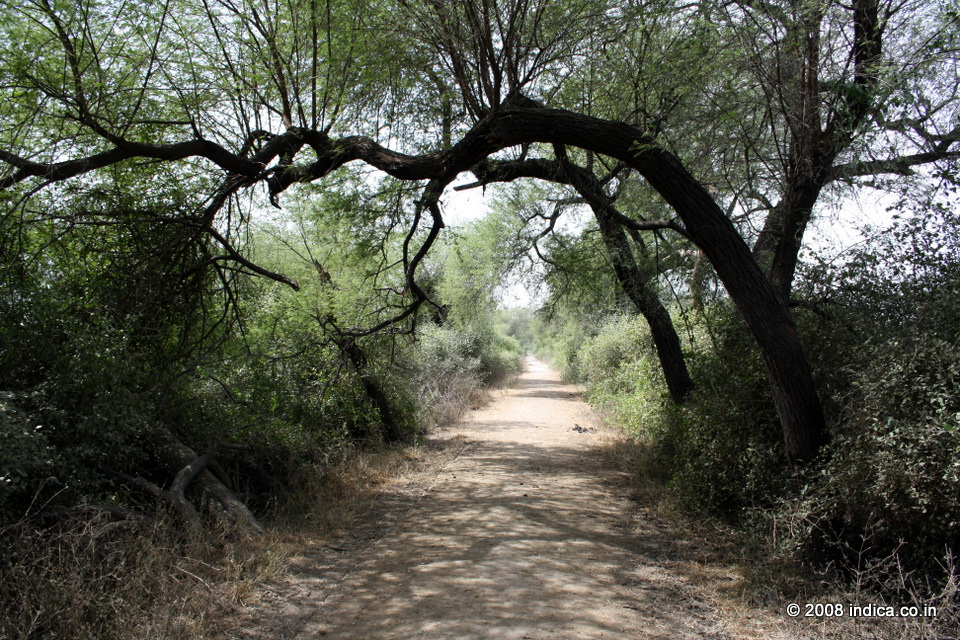
There are numerous such trails in the park. One of the many trails in the park. Rickshaws are not allowed in many such trails.
There are numerous such trails in the park.
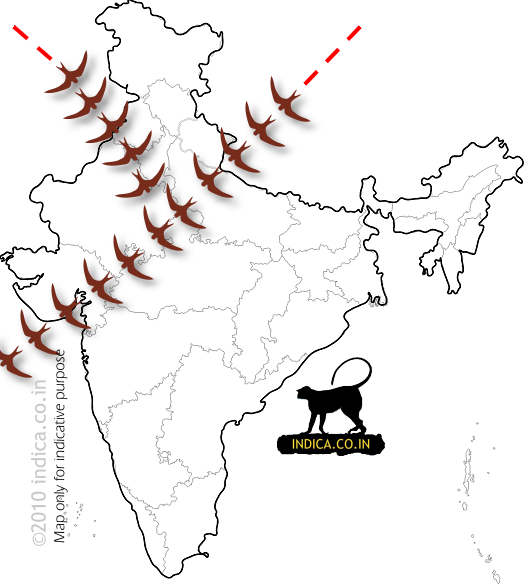
Bird migratory path in northwest India
Bird migratory path in northwest India
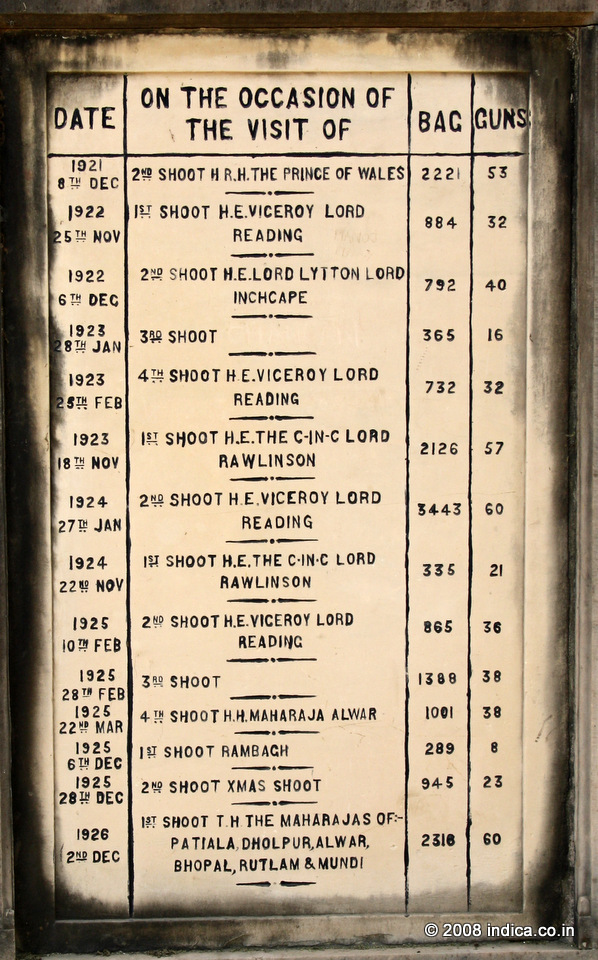
Records of duck shoots by the Maharajas and their friends!
Later the maharajas even arranged duck shoots to honor the visiting dignitaries. The highest kill ever recorded was in 1938 during annual duck shoot conducted in the hounour of Lord Linlithgow, the then Governor General of colonial India. A total of 4,273 birds were killed.
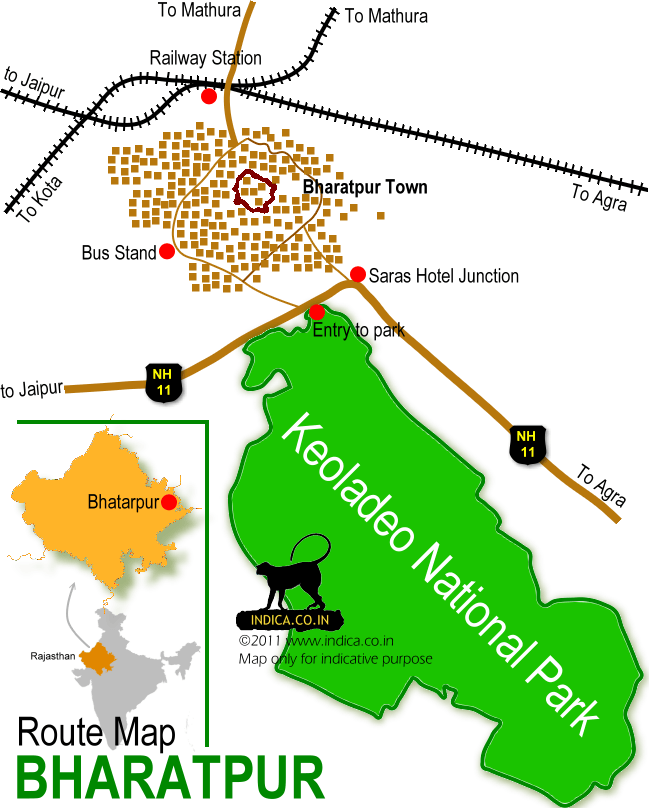
Location and route map for Keoladeo National Park in Rajasthan.
Location and route map for Keoladeo National Park in Rajasthan.
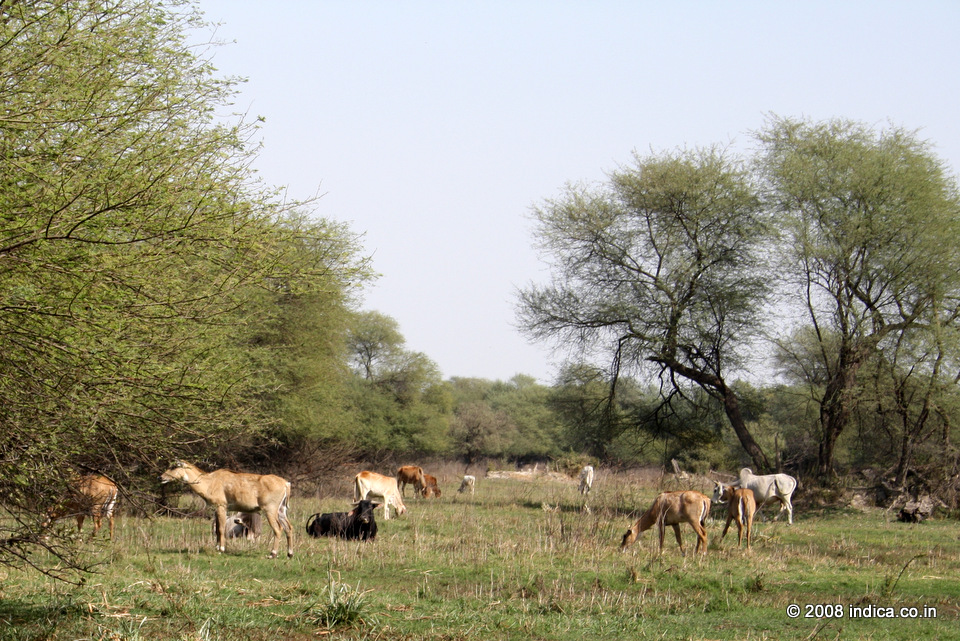
Feral cattle inside the national park
Feral cattle inside the national park
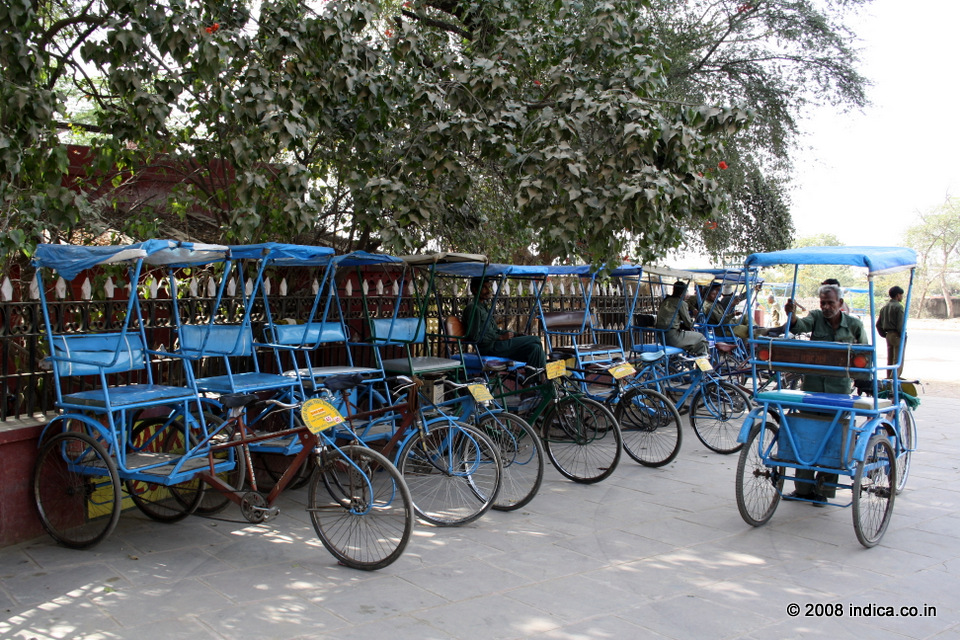
cycle rickshaws stand at the gateway to the Keoladeo National Park.
cycle rickshaws stand at the gateway to the Keoladeo National Park.
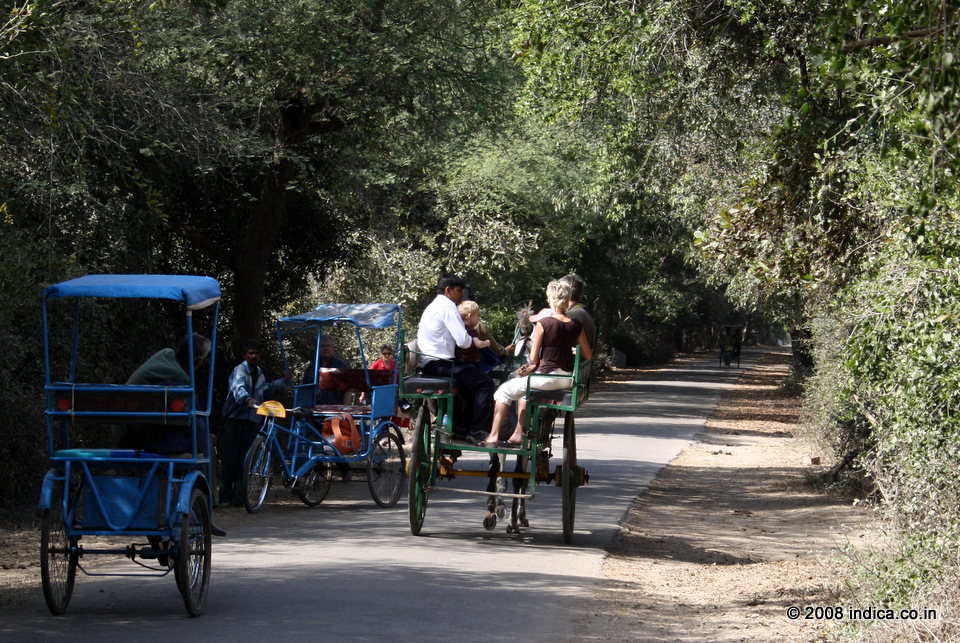
The popular choice is the cycle rickshaws to tour the Keoladeo National Park.
The popular choice is the cycle rickshaws to tour the Keoladeo National Park.
